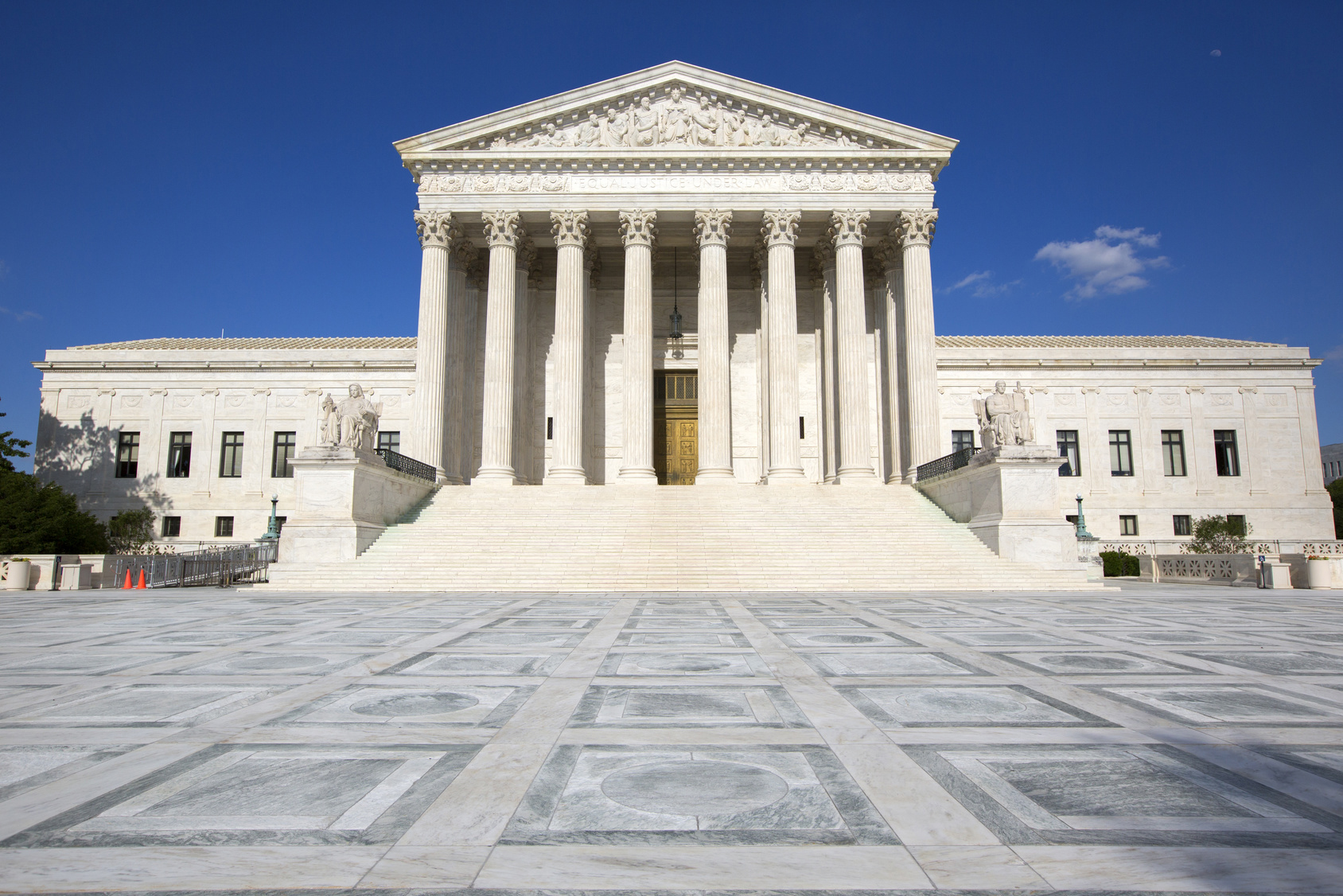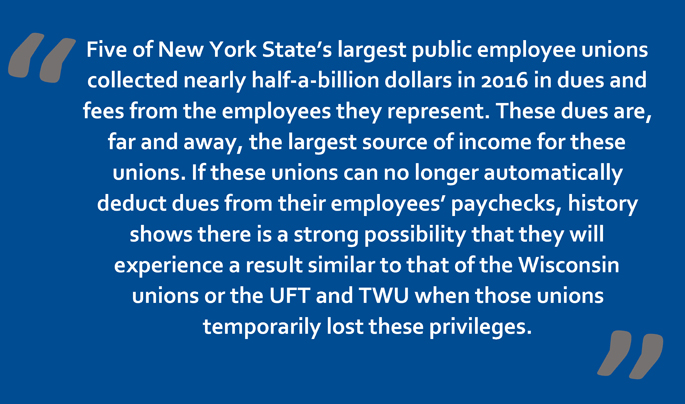One of the most immediate impacts of Neil Gorsuch’s appointment to the Supreme Court may be on a case that could have a major impact on public employee unions right here in New York.
CASE OVERVIEW
This case, Janus v. AFSCME, deals with state laws that allow public employee unions to automatically withhold fees or dues from all represented employees’ paychecks, even those who are not members of the union. The plaintiff in the case, Mark Janus, is an employee of the state of Illinois. He is suing his union, the American Federation of State, County and Municipal Employees (AFSCME), because he believes the Illinois state law allowing AFSCME to deduct monies from his paycheck violates his First Amendment rights to freedom of speech and association. New York has a similar law on its books. Illinois and New York are two of 22 states that allow for arrangements under which all represented employees must make payments to a union as a condition of their employment, even if they affirmatively elect not to join the union.
In order to succeed in his effort, Janus and his allies recognize that they must convince the Supreme Court to overturn the precedent it set in 1977. In Abood v. Detroit Board of Education, the Court ruled that mandatory deductions in the public sector were legal. On March 21, 2017, the 7th U.S. Circuit Court of Appeals concurred that only the Supreme Court could overturn this precedent. Media reports indicate this case may be taken up in the 2017 fall term with a possible 2018 decision date.
Observers anticipate the Janus case may succeed in overturning Abood because of the case’s similarity to another one, Friedrichs v. California Teachers Association, which was before the Supreme Court last year. Friedrichs similarly pitted a public employee, Rebecca Friedrichs, against the California Teachers Association, to which she was mandated to contribute a portion of her salary as a condition of her employment.
In the oral arguments held in January 2016, a five justice majority seemed ready to overturn the Aboodprecedent (an earlier 2014 decision, Harris v. Quinn, similarly hinted that the Court may be ready to make this shift). However, Justice Antonin Scalia passed away on February 13, 2016, before a ruling could be issued, and the Supreme Court ultimately issued a tie (4-4) ruling in March upholding the Aboodprecedent. Court watchers anticipate that Justice Gorsuch will join the side arguing that mandatory deductions are unconstitutional.
POTENTIAL IMPACT
It is difficult to overstate the impact that such a shift could have on organized labor in this country and particularly in New York. If employees are no longer mandated to contribute to the unions representing them, observers expect affected public employee unions to experience a significant decline in member contributions. Indeed, the New York State United Teachers (NYSUT) passed a resolution after the confirmation of Justice Gorsuch in April 2017, stating that the Janus v. AFSCME lawsuit and similar suits are intended to “deliver a crippling blow to the labor movement … in the United States.”
Examples from prior years suggest that a large impact is likely. In June 2007, after its three-day December 2005 strike against the Metropolitan Transportation Authority (MTA), the Transport Workers Union (TWU) Local 100 lost the ability to automatically withhold dues from its members’ paychecks (similar to what would occur if Janus is successful). Almost immediately, the union appealed this ruling to the courts, but it was not until November 2008 when mandatory deductions were restored. According to reports filed with the federal government, TWU Local 100 2008 annual dues dropped $3.3 million from 2006.
The New York City teachers’ union, the United Federation of Teachers (UFT), also had a large drop in dues after a two-year suspension of mandatory deductions was imposed in 1982 for a five-day September 1975 strike. In its appeal to the state Public Employment Relations Board (PERB), UFT successfully “demonstrated that, despite substantial vigorous and costly efforts, it has been unable to collect necessary income; it has shown that representational services have already been impaired and that the continuation of the penalty will lead to the elimination or diminution of other necessary and material services to the public employees.” PERB reinstated UFT’s ability to automatically collect union dues from members’ paychecks after only a three-month break. In just those three months in 1982, however, UFT lost more than $2 million in member dues, which would have resulted in a $16 million loss of dues if the full two-year penalty had been imposed.
More recently, other states, such as Wisconsin, have passed “right to work” laws at the state level effectively implementing what will occur if the Janus case is successfully appealed. After 2011 and 2015 changes to reduce unions’ collective bargaining rights, union membership in Wisconsin decreased by approximately 136,000 people — a 38 percent decrease from 2010 levels.
EFFECT ON NEW YORK
If the Abood precedent is overturned, New York will feel a disproportionately large impact. According to the federal Bureau of Labor Statistics (BLS), 23.6 percent of all workers in New York (1.94 million employees) belong to a union, which is the highest unionization rate in the country. Another source based on BLS data further shows that New York’s high overall unionization rate is based on its extremely high rate of public employee unionization, and estimates that 67.3 percent of public employees in New York belong to a union. This is the highest in the nation as well (see below for more details).
With such a high number of unionized public employees, the impact of overturning Abood would be substantial: Five of New York State’s largest public employee unions (UFT, NYSUT, the Civil Service Employees Association, the Public Employees Federation, and District Council 37) collected nearly half-a-billion dollars in 2016 in dues and fees from the employees they represent. These dues are, far and away, the largest source of income for these unions. If these unions can no longer automatically deduct dues from their employees’ paychecks, history shows there is a strong possibility that they will experience a result similar to that of the Wisconsin unions or the UFT and TWU when those unions temporarily lost these privileges.
Unions use dues from their members to fund their operations. In 2016, these five unions spent $158.5 million on “representational activities,” which are disbursements associated with collective bargaining with public employers. In addition, these five unions spent $21.7 million on “political activities and lobbying.” In its most recent annual report on lobbying activity, the Joint Commission on Public Ethics (JCOPE) found that NYSUT had the second highest spending total on lobbying expenditures across the state.
Thanks to the state’s Public Employees’ Fair Employment Act, often referred to as the Taylor Law, public employee unions in New York have traditionally been major institutional forces that influence New York’s policy making agenda. If Janus v. AFSCME successfully overturns the 40-year old Abood precedent, this status quo will likely be disrupted.


